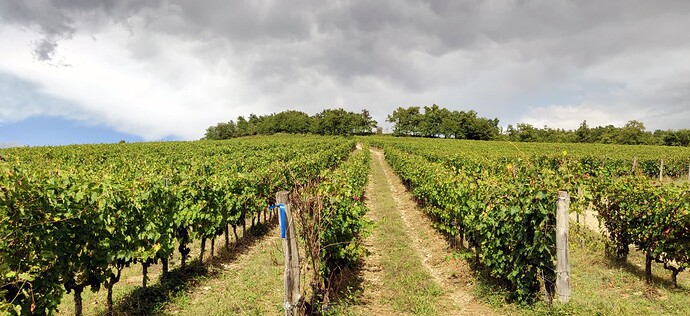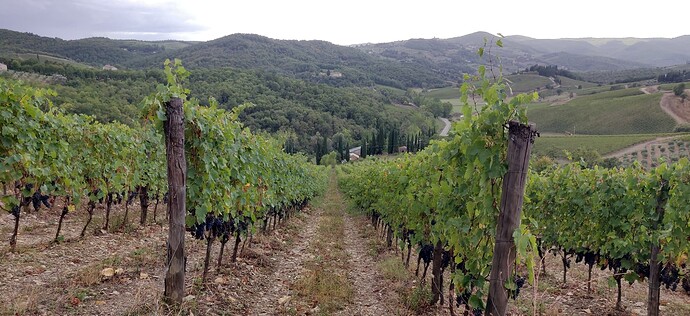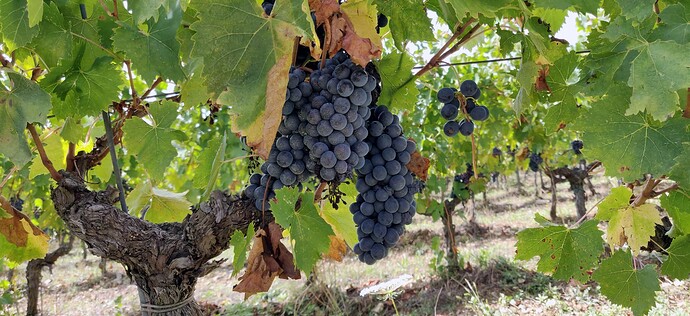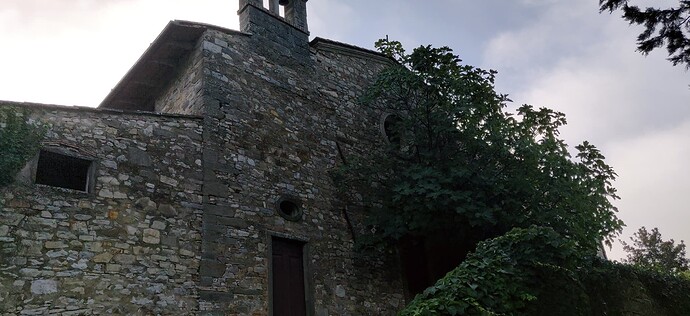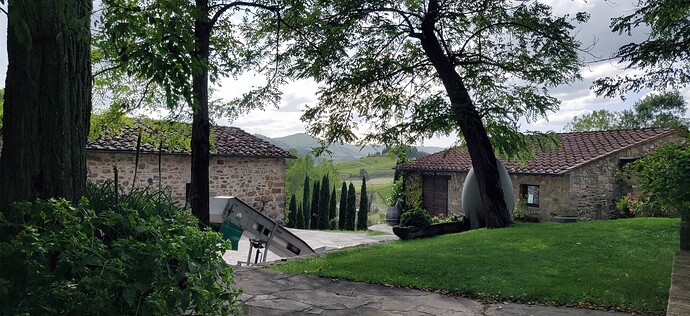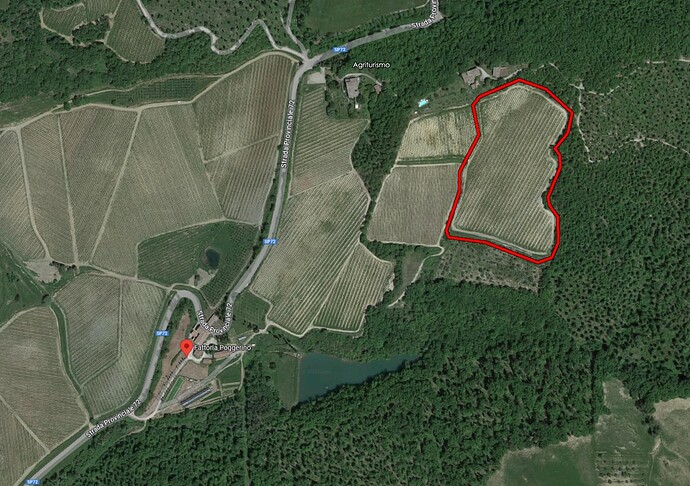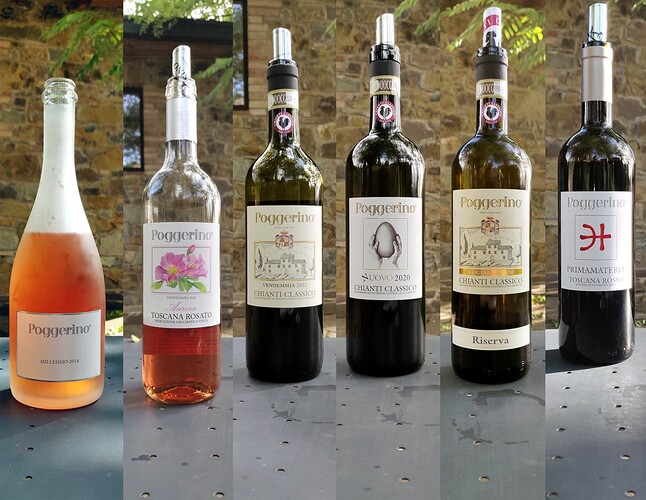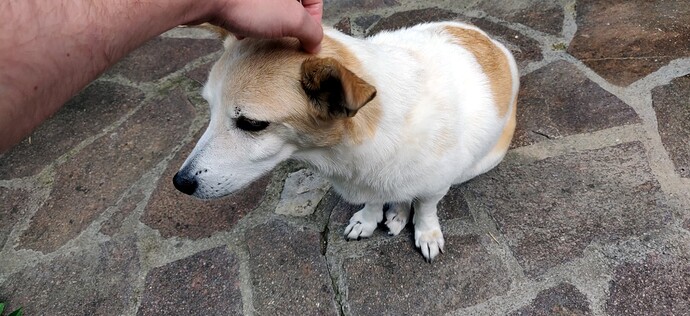Our third - and last - winery visit in Radda in Chianti was at Fattoria Poggerino, ie. the place we were also staying over for a few nights. Thus, the trip to the winery wasn’t too hard: all we had to do was to walk down the 400 m trip (and 100 m descent!) from the agriturismo almost on top of the hill to the winery at the base of the hill. Although the steepness of the slope did make the descent a bit difficult!
The photo (taken from the base of the hill in the direction of the agriturismo) might not have the best sense of perspective, but the hillside is pretty steep!:
Fattoria Poggerino
The winery has its beginnings in the 1980’s, but the estate is much older: it belonged to Prince Ginori Conti, a member of one of the old Florentine families. Floriana Ginori Conti - mother of the current owner, Piero Lanza - inherited part of the property from her father in 1973. Together with her husband Fabrizio Lanza, she started producing wine under the Poggerino label in 1980.
Piero Lanza started making wine at the estate in 1988 and took over the estate with his sister, Benedetta Lanza, in 1999. Today Piero Lanza is responsible of viticulture and winemaking, while Benedetta Lanza takes care of the agriturismo side of the business.
Rows of Sangiovese leading towards the winery (you can also see the trees surrounding the Montevertine winery on the hill, right above the right-hand vineyard post):
Under Piero’s leadership the winery has converted its vineyards to organic farming (certified in 2012) and employing biodynamics in the viticulture as well. During his time also the style of wines has moved away from the darker-toned, more international oak-forward style and towards a more traditional style of Chianti, employing long maceration times and either old oak botti or concrete tanks.
Most Sangiovese was still waiting for the harvest:
The estate encompasses three poderi: the winery and administration buildings are located beneath the vineyards, at the altitude of 400 m above sea level; the b & b is located some 400 meters away, right above the vineyards, at the altitude of 500 m above sea level; there’s a third podere in the vicinity of the b & b, on a small hill on top of the larger hill, giving the estate its name, Poggerino (meaning “a small hill”). Originally the winery name confused me a bit, since the hill on which the vineyards are, is definitely not a small one! However, this etymology clarified things a lot.
The agriturismo building:
The estate covers around 43 hectares, of which 12,5 is under vine; 11,5 hectares of Sangiovese and 1 ha of Merlot. There is also a tiny bit of Canaiolo and a few odd rows of Cabernet Sauvignon. I was told Piero experimented with Cab, but even a small addition just cut through in a way he didn’t like, so it never really made it to their Chianti. I wasn’t told whether the few Cab grapes go into some other wine, though! I understood the tiny Canaiolo component usually is used in the production of the basic Chianti Classico. The annual output of the winery is normally around 65,000 to 70,000 bottles.
The winery part of the estate:
We didn’t take the winery tour with Piero Lanza, because our schedules that day didn’t really suit a longer visit; instead we just tasted through the range of wines and I managed to steal a small peek into the winery. We did see Piero during our stay, however; he seemed to be always in a hurry, coming from or going somewhere, or just giving a winery tour for the visitors. My only communication with him was when he passed us by and I managed to deliver him greetings from Signora Elisabetta of Montenidoli - who said during our visit at Montenidoli that she holds Piero Lanza in high regard and told us he is doing very fine things in Radda (this seemed to be reflected by the other local winemakers as well, whenever we told we were staying at Poggerino).
It total Fattoria Poggerino makes seven wines:
- Il Labirinto - an entry-level Sangiovese aged in concrete tanks
- Aurora Rosato - a rosé made from a blend of early-harvested Sangiovese and a portion bled off from the red wines
- Spumante Rosé Millesimo - a bottle-fermented Sangiovese rosé sparkling wine aged for an extended period on the lees
- Primamateria - a blend of Merlot and Sangiovese, aged in partly new French oak tonneaux
- Chianti Classico - the traditionalist wine and the backbone of the winery; 100% old-school Sangiovese
- Chianti Classico Nuovo - made with a clone of Sangiovese producing larger bunches of thin-skinned grapes, aged in Nomblot egg-shaped concrete tanks
- Chianti Classico Riserva Bugialla - a single-vineyard Chianti made with old-vine fruit sourced from the highest-altitude vineyard
Here’s the map of the estate (everything on the right side of Strada Provinciale 72); the vineyard that supplies the fruit for the Riserva is encircled in red:
We tasted the following wines:
-
2014 Fattoria Poggerino Spumante Rosé Millesimo - Italy, Tuscany, Toscana IGT (23.9.2023)
Made with organically farmed Sangiovese grapes - the earliest ones to be harvested at the estate - usually picked in late August or early September, depending on the vintage. Macerated briefly with the skins during the crush. Fermented spontaneously and aged on the lees with periodical bâtonnage until the spring following the harvest, when the wine is clarified, filtered and bottled. Aged on the lees for 6,5 years, disgorged on 18th of November, 2021. A portion of annual production is made into liqueur d'expédition that is used to fill the disgorged bottles, so the wine is 100% from one single vintage only. 12% alcohol, 4 g/l dosage. Bottled under IGT Toscana Rosato Frizzante appellation. Total production 1,000 bottles.
Pale seared salmon color. The nose feels characterful and quite distinctive with aromas of raspberries and even some slightly vegetal raspberry leaf tones, some developed notes of caramel, a little bit of cooked rose hips, light evolved meat stew tones, a hint of smoke and a touch of toasty autolysis. The wine feels dry, fresh and pretty crisp on the palate with a light-to-medium body and quite complex flavors of tart Granny Smith apple and lingonberry, some evolved bruised apple and caramel tones, light saline mineral nuances, a little bit of developed, meaty umami character, a hint of crunchy redcurrant and a touch of toasty autolysis. The mousse feels fine and creamy and the acidity feels pretty crisp and racy. The finish is crisp, dry and palate-cleansing with a long, brisk aftertaste of saline minerality and lemony citrus fruit, some sharp Granny Smith apple tones, a little bit of tart lingonberry, light stony mineral nuances and a hint of toasty caramel character.
A characterful, balanced and very serious sparkling rosé. Although the wine is officially a Rosato Frizzante, the appellation does the wine no justice, because it is qualitatively on par with great Rosé Champagnes. Sangiovese picked up this early doesn't show that many varietal characteristics - at least those one might find from a red Sangiovese - but instead resulting in a relatively light and positively neutral base wine, which give enough room for the evolved tertiary notes and toasty qualities of autolysis shine through. The wine is wonderfully structured and harmonious with great depth of flavor. Perhaps those slightly evolved meaty notes might put some people off, but I found they only added to the savory complexity. Good stuff. Solid value at 30€.
(91 points) -
2022 Fattoria Poggerino Aurora Toscana IGT - Italy, Tuscany, Toscana IGT (23.9.2023)
100% organically farmed Sangiovese from vineyards planted between 1994 and 2004. The base wine is made with the earliest grapes to be harvested at the estate, usually picked in late August or early September, depending on the vintage, fermented spontaneously and macerated with the skins for 60-90 minutes. Later on, in late September or early October, a portion of must is bled off from the fermenting Chianti Classico and added to the rosé. Typically the wine is a 50/50 blend of rosé de maceration and rosé de saignée, but the saignée portion varies depending on the vintage: in cooler vintages it can be higher and in warmer vintages lower than 50%. Fermented and aged in stainless steel. 13% alcohol.
Luminous and rather deep salmon-pink color. The nose feels youthful, even primary, but also somewhat closed with aromas of savory spice, some sweet fermentation esters, a little bit of strawberry, light white peach and a hint of stewed herbs. The wine feels firm and quite linear on the palate with a rather light body and dry flavors of crunchy cranberries and sour cherries, some spicy notes, a little bit of tart rowanberry and a hint of stony minerality. High acidity. The finish is dry, crunchy and juicy with a medium-long aftertaste of redcurrants and cranberries, some stony mineral notes, a little bit of savory spice and a hint of sour cherry bitterness.
This wine left me quite unmoved. Both the nose and the taste feel rather simple and linear and the aftertaste feels quite brief. I love the freshness from the high acidity here, but that's about it. This is a very simple and uninteresting everyday rosé that feels like it is in the lineup because they are popular today and every winery should have one - not really because the winery would really want to make them or attempts to make a best possible wine out of their rosé. Well, at least the wine isn't particularly pricey at 12€.
(80 points) -
2021 Fattoria Poggerino Chianti Classico - Italy, Tuscany, Chianti, Chianti Classico DOCG (23.9.2023)
100% organically farmed Sangiovese from vineyards planted between 1994 and 2004 that are typically harvested between late September and early October. The fully destemmed grapes are fermented spontaneously and macerated with the skins in concrete fermentors for 35 days. In December the fermented wines are racked into Slavonian oak botti of 2000 to 2500 liters - and old French oak tonneaux of 400 to 500 liters, if need be - for the MLF. After a minimum aging of 12 months, the wines are bottled, typically in the spring. 14,5% alcohol.
Deep, youthful and rather opaque dark cherry-red color. The nose feels open and attractively fragrant, showing wonderful purity of fresh Sangiovese fruit: red forest fruits and black cherries, some fresh boysenberry tones, a little bit of youthful floral character, light licorice root tones, a hint of raspberry juice and a touch of crunchy redcurrant. Lovely! The wine feels youthful, somewhat silky yet at the same time very sinewy and almost lean on the palate with a medium body and intense flavors of pronounced sour cherry tones along with tart lingonberry, some crunchy notes of fresh red plums, a little bit of redcurrant, light bitter notes of medicinal herbs and a hint of old, dry leather. The overall feel is firm and quite structure-driven, thanks to the high acidity and still very unresolved and quite grippy tannins. The finish is dry, quite grippy and wonderfully acid-driven with a long, crunchy aftertaste of tart lingonberries and redcurrants, some old leather, a little bit of sour cherries, light bitter notes of medicinal herbs, a hint of earth and a woody touch of savory old oak spice.
A fine, balanced and very classically built Chianti Classico that is still super youthful but starting to enter its drinking window. Despite its youthful overall feel, the wine isn't a light and playful little wine, but instead a quite stern and dead-serious effort made in a very structure-driven style. A fine and delicious allrounder that goes easily with most Italian fare that calls for red wine. Will age gracefully for a decade or perhaps even two. Good value at 20€.
(91 points) -
2020 Fattoria Poggerino Chianti Classico Nuovo - Italy, Tuscany, Chianti, Chianti Classico DOCG (23.9.2023)
Nuovo means "new" and uovo translates to "egg". 100% organically farmed Sangiovese from a vineyard planted in 1984 to a clone that produces larger bunches of grapes that have a bigger juice-to-skin ratio than the other clones planted at the estate - the initial experiments with the concrete egg-shaped tanks in the early 2010's resulted in wines that were too tough and tannic, so this problem was mitigated by bigger thin-skinned grapes resulting in less tannic wines. The grapes are typically harvested between late September and early October. The fully destemmed grapes are fermented spontaneously and macerated with the skins in stainless steel tanks for 35 days. In December the fermented wines are racked into 650-liter Nomblot concrete eggs. After 12 months of aging, the wines are bottled - this vintage in January 2022. 14,5% alcohol.
The wine appears slightly evolved with its somewhat translucent and subtly maroon cherry-red color. The nose feels characterful and similarly a bit evolved with its aromas of meat stew, some wizened dark fruits, a little bit of fresh cherry and ripe strawberry, light balsamic tones, a hint of earth and a touch of stewed herbs. The wine feels firm, dry and rather stern on the palate with a medium body and intense flavors of fresh cherries and sour cherry bitterness, some stony mineral tones, a little bit of balsamic character, light brambly notes of raspberries, a hint of tobacco and a savory touch of meaty umami. The overall feel is quite muscular and tightly-knit, thanks to the high acidity and quite grippy, assertive tannins. The finish is dry, savory and grippy with a rather long and slightly evolved aftertaste of fresh red cherries and sour cherries, some sweeter notes of wizened dark fruits, a little bit of meaty umami, light earthy tones, a hint of tobacco and a touch of chalky minerality.
I was a bit surprised when tasting the wine as it seemed somewhat more evolved than the 2021 CC and 2020 CCR that were tasted alongside - I don't know if this is characteristic of this wine or if this particular bottle had been opened much earlier. When tasting the wine, you can really understand why the producer concentrated on the bigger, thin-skinned Sangiovese grapes for this wine; normally those grapes yield a lighter, softer wine, but still this wine is noticeably stern, tough and tannic in nature. I can imagine the wine might've been quite unyielding and unpleasant when made from the smaller grapes that have a larger skin-to-juice ratio! Comparing to the regular Poggerino CC, this Nuovo shows more depth, complexity and tannic structure. However, this wine (or at least this bottle) doesn't seem to promise as much aging potential due to its somewhat evolved, meaty and earthy overall character. I'd say this wine will continue to evolve and improve for at least a handful of years, but it feels the wine should be drank earlier than Poggerino's other Chianti Classicos. Priced according to its quality at 32€.
(92 points) -
2020 Fattoria Poggerino Chianti Classico Riserva Bugialla - Italy, Tuscany, Chianti, Chianti Classico DOCG (23.9.2023)
100% organically farmed Sangiovese from the south-facing vineyard planted in 1974 on the highest slopes at the estate, at approx. 500 m above sea level. The vineyard is typically harvested in late September. The fully destemmed grapes are fermented spontaneously and macerated with the skins in concrete fermentors for 55 days. In December the fermented wines are racked into Slavonian oak botti of 2000 to 2500 liters for the MLF. After a minimum aging of 18 months, the wines are bottled, typically in the spring. 14,5% alcohol.
Deep, dark and rather opaque blackish-red color with a faint maroon hue. The nose feels wonderfully fragrant and open with harmonious, layered aromas of sweet black cherries, some balsamic tones, a little bit of old leather, light plummy tones, a floral hint of violets and a touch of gamey meat. The wine feels ripe, concentrated and textural on the palate with a rather full body and very intense flavors of fresh black cherries and ripe raspberries, some earthy tones, a little bit of balsamic richness, light notes of tobacco, a hint of sour cherry bitterness and a savory touch of woody old oak spice. The overall feel is quite muscular and structured yet not too tough or aggressive with the high acidity and ample yet ripe ripe tannins. The finish is rich, juicy and quite noticeably grippy with a long and pretty intense aftertaste of sour cherries and sweeter black cherries, some savory notes of meaty umami, light woody notes of old oak, a little bit of balsamic richness, a hint of tobacco and a touch of balancing bitterness. The high alcohol makes the wine end on a subtly warm note.
A rather ripe and slightly warm but also very fresh, balanced and structure-driven Chianti Classico Riserva. Although the overall style is slightly darker-toned and more ripe compared to the basic-level Chianti Classico, the wine still comes across as very harmonious and classically styled in character. With its intense, concentrated and wonderfully pure Sangiovese fruit and impressive structure, I have no doubts this wine will evolve gracefully for another decade or two. Although the wine is perfectly enjoyable at the moment, I'd suggest letting it age for at least some years more in order to coax out some more developed complexity. A fine wine and solid value at 35€. Highly recommended.
(93 points) -
2020 Fattoria Poggerino Primamateria Toscana IGT - Italy, Tuscany, Toscana IGT (23.9.2023)
A blend of organically farmed Merlot (50%) from a vineyard planted in 1999 and Sangiovese (50%) from a vineyard planted in 1996. Typically Merlot in harvested in late September and Sangiovese in early October, both varieties vinified separately. The fully destemmed grapes are fermented spontaneously and macerated with the skins in concrete fermentors for 35 days. In December the fermented wines are racked into 400-liter French tonneaux (25% new) for the MLF. After a minimum aging of 18 months, the wines are bottled, typically in the spring. To my understanding, this 2020 vintage was aged for two years in oak. 14,5% alcohol.
Youthful, luminous, somewhat translucent dark ruby-red color. The dark-toned nose feels ripe and somewhat sweetly-fruited with aromas of black cherries and strawberries, some marmaladey red cherry tones, a little bit of sweet spice, light woody notes of oak, a hint of licorice and a faint touch of vanilla. The wine feels silky in texture on the palate with a full body and ripe, dry-ish flavors of juicy red plums, some sour cherry bitterness, a little bit of tobacco, light earthy notes, a hint of tart lingonberry and a touch of sweet, toasty oak spice. The overall feel is balanced and moderately structured with the moderately high acidity and ripe medium tannins. The finish is dry, slightly warm and somewhat grippy with a long aftertaste of fresh red plums, some tart lingonberries, a little bit of tobacco, light earthy notes, a hint of sour cherry bitterness and a touch of toasty oak spices.
I was amused when I was told at the winery how people normally react to this wine along the lines of "finally, a REAL red wine!" when it is served as the last wine, after three Chianti Classicos; my reaction was completely the opposite! To me, after three very firm, structured and classically styled Sangioveses the slightly softer and noticeably more "modern" style of Primamateria stood out in start contrast, but not in a particularly good way. I still have to point out that even though I'm not a fan of modern Super Tuscan reds, this was a surprisingly nice and serious effort in the genre: the oak impact was actually quite subtle and the wine was firm and dry with good sense of structure and typicity. Even if the wine was made in a rather modern style, the overall feel was definitely that of a Tuscan red. I can understand why some people might like this kind of softer, slightly sweeter-toned and more fruit-forward wine over Poggerino's leaner, drier and more structured Sangioveses, but I'm just very partial to the classically styled Chianti Classicos. Still, this is a very nice wine and I would happily buy and cellar this - but if I had choice, I'd still go for the Chianti Classicos! Priced according to its quality at 27€. I'd let the wine age some years more, in the hopes that the oak influence would integrate better with the fruit.
(90 points)
Posted from CellarTracker
And this absolute unit of a winery dog kept us company every morning at the breakfast patio:
